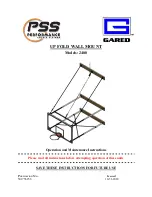
USE R GUI DE
|
P OR T A -R AY
®
4 0 0 R
5
Shield the Source of UV Light
Any substrate that blocks UV light can be used as a shield
to protect workers from stray UV light. The following
materials can be used to create simple shielding
structures:
Sheet Metal
–
Aluminum, steel, stainless steel, etc. Sheet
metal should be coated black or black anodized to
minimize reflection of UV and visible light toward
operators.
Rigid Plastic Film
–
Transparent or translucent, UV-
blocking plastics (typically polycarbonate or acrylic) are
commonly used to create shielding where some level of
transparency is also desired.
Flexible Film
–
Translucent UV-blocking, flexible urethane
films can be used to quickly create workstation shielding.
This UV-blocking, flexible urethane film is available from
Dymax.
High-Temperature Surfaces
Surfaces exposed to high-intensity curing lights will rise in
temperature. The intensity, distance, exposure time,
cooling fans, and the type/color of the surface can all
affect the actual surface temperature. In some cases,
exposed surfaces can reach temperatures capable of
producing a burn or causing damage to a substrate. In
these cases, care must be taken to ensure either a more
moderate surface temperature or appropriate protection/
training for operators.
Ozone
Standard Dymax bulbs (UVA type) generate an
insignificant amount of UVC and therefore essentially no
ozone. Some UV-curing systems, like those used to cure
UV inks, emit primarily “shortwave” (UVB and UVC)
energy. Upon exposure to UVC light (specifically <240
nm), oxygen molecules (O
2
) split into oxygen atoms (O)
and recombine with O
2
to create ozone O
3
. The current,
long-term ozone concentration limit recommended by
ACGIH, NIOSH, and OSHA is 0.1 ppm (0.2mg/m
3
).
Bright, Visible Light
The bright, visible light energy emitted by curing systems
can cause eyestrain if proper eye protection or shielding is
not used. Tinted eye protection and/or opaque/tinted
shielding can be utilized to address this concern.
Summary
UV-
light sources can be more “worker friendly” than many
commonly accepted industrial processes, provided the
potential concerns are addressed. Both the lower working
temperature and lack of spurious frequency transmission
that this system produces make it even more user friendly.
Contact your Dymax representative for information
regarding the proper use of Dymax UV light-curing
systems.
Figure 1.
Spectrum of Light
Содержание PORTA-RAY 400R
Страница 1: ...PORTA RAY 400R Portable UV Light Curing Flood Lamp User Guide ...
Страница 19: ...USER GUIDE PORTA RAY 400R 19 ...






































